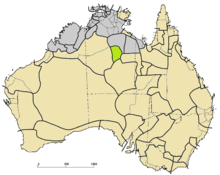Warumungu language
| Warumungu | |
|---|---|
| Region | Northern Territory, Australia |
| Ethnicity | Warumungu people, Kunapa |
Native speakers | 321 (2016 census)[1] |
Language family | Pama–Nyungan
|
Signed forms | Warumungu Sign Language |
| Language codes | |
| ISO 639-3 | wrm |
| Glottolog | waru1265 |
| AIATSIS[2] | C18 |
| ELP | Warumungu |
 Warumungu (green) among other Pama–Nyungan languages (tan) | |
The Warumungu (or Warramunga) language is spoken by the Warumungu people in Australia's Northern Territory. In addition to spoken language, the Warumungu have a highly developed sign language.
Classification[]
The Warumungu language is a Pama–Nyungan language similar to the Warlpiri language spoken by the Warlpiri people.
History[]
In the 1870s, early white explorers described the Warumungu as a flourishing nation.[3] However, by 1915, invasion and reprisal had brought them to the brink of starvation.[3][4] In 1934, a reserve that had been set aside for the Warumungu in 1892 was revoked in order to clear the way for gold prospecting. By the 1960s, the Warumungu had been entirely removed from their native land.[3]
Current status[]
Warumungu is classified as a living language,[5] but its number of speakers seemed to be decreasing quickly. In the mid-1950s, Australian linguist Robert Hoogenraad estimated that there were only about 700 people who could speak some Warumungu;[6] by 1983, the population was estimated to be as small as 200 speakers.[7]
However, the language has evidently undergone something of a renaissance. Today, the language is in a robust position compared to many indigenous Australian languages, as it is being acquired by children and used in daily interaction by all generations, and the situation is sustainable though some ethnic group members may prefer Kriol.
Syntax and morphology[]
Warumungu is a suffixing language, in which verbs are formed by adding a tense suffix (although some verbs are formed by compounding a preverb).[4] As are many of the surviving Indigenous Australian languages, the Warumungu language is undergoing rapid change. The morphology used by younger speakers differs significantly than the one used by older speakers.[4] An example of a Warumungu sentence might be apurtu im deya o warraku taun kana, meaning 'father's mother, is she there, in town, or not?'.[8]
External links[]
References[]
- ^ ABS. "Census 2016, Language spoken at home by Sex (SA2+)". stat.data.abs.gov.au. Australian Bureau of Statistics. Retrieved 29 October 2017.
- ^ C18 Warumungu at the Australian Indigenous Languages Database, Australian Institute of Aboriginal and Torres Strait Islander Studies
- ^ a b c The Warumungu: The Land is Always Alive Retrieved 23 December 2008 Archived 20 July 2008 at the Wayback Machine
- ^ a b c Blackwell-Reference Online: Warumungu (Australian: Pama–Nyungan) Retrieved 23 December 2008
- ^ "The Warumungu Language". LINGUIST List. Retrieved 24 December 2008.
- ^ Aboriginal Child Language Acquisition Project: Warumungu Retrieved 22 December 2008
- ^ "Ethnologue report for language code:wrm." in Gordon, Raymond G., Jr. (ed.), 2005. Ethnologue: Languages of the World, Fifteenth edition. Dallas, Tex.: SIL International.
- ^ Scholar Sceptic: Australian Aboriginal Studies Retrieved 23 December 2008
- Pama–Nyungan languages
- Languages of Australia